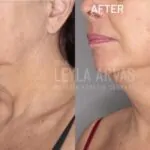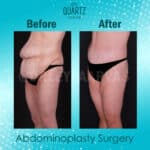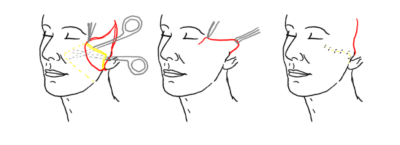 SMAS Face Lift, which aims to lift the sagging tissues of the face back to their former location, is the most popular face lift technique, especially in recent years, and has the longest permanence with very natural results.
SMAS Face Lift, which aims to lift the sagging tissues of the face back to their former location, is the most popular face lift technique, especially in recent years, and has the longest permanence with very natural results.
What is SMAS Face Lift?
SMAS (Superficial Musculoaponeurotic System) Face Lift is a type of cosmetic surgery procedure used to tighten and lift the skin on the face and neck, giving a more youthful appearance. It involves the repositioning and tightening of the underlying SMAS layer to improve the contours of the face. The SMAS Face Lift is a surgical procedure that targets the deep tissue layers of the face and neck, rather than just the skin.
The SMAS is a sheet of muscle and fascia that lies beneath the skin and is responsible for many facial movements. By repositioning and tightening the SMAS layer, the surgeon can improve the contours and appearance of the face.
The procedure is typically performed under general anesthesia and can take several hours to complete. Incisions are made in inconspicuous areas, such as the hairline or inside the mouth, to minimize scarring. The surgeon will then reposition and tighten the SMAS layer and remove excess skin. The incisions are closed and the patient is typically required to wear a supportive bandage for several days after the surgery.
The results of a SMAS facelift can be long-lasting, with some patients experiencing a more youthful appearance for several years after the procedure. However, it is important to keep in mind that the results of any cosmetic surgery procedure can be influenced by factors such as age, skin quality, and lifestyle habits
Benefits of a SMAS Face Lift
There are many benefits to choosing a SMAS face lift over other facial rejuvenation procedures. Some of the benefits include:
- A more natural-looking result: The SMAS face lift targets the underlying tissue of the face, which results in a more natural-looking outcome. This is because the procedure addresses the cause of aging, rather than just the symptoms.
- A longer-lasting result: Because the SMAS face lift addresses the underlying tissue of the face, the results of the procedure can last for several years, often longer than traditional face lift procedures.
- Minimal scarring: The incisions made during the SMAS face lift are typically hidden within the hairline or natural creases of the face, resulting in minimal scarring.
- Quicker recovery time: The recovery time for a SMAS face lift is typically shorter than a traditional face lift, allowing patients to return to their normal activities sooner.
Who is Suitable for SMAS Face Lift?
A SMAS face lift is suitable for individuals with sagging skin, wrinkles, and loss of volume in the mid-to-lower face. The procedure is typically recommended for people who are in good overall health and have realistic expectations for the results of the surgery. It is best to consult with a plastic surgeon to determine if a SMAS facelift is right for you.
How is the SMAS Face Lift Operation Performed?
SMAS (Superficial Musculo-Aponeurotic System) face lift is a type of facial rejuvenation surgery that involves lifting and tightening the underlying facial muscles and tissues to improve the appearance of the skin. The procedure is typically performed under general anesthesia and involves the following steps:
- An incision is made along the hairline, extending in front of the ear and behind the ear.
- The SMAS layer is lifted and tightened to improve facial contours and reduce sagging.
- Excess skin is trimmed, and the remaining skin is re-draped over the tightened SMAS layer.
- The incisions are closed with sutures or surgical tape.
- It’s important to note that the specific steps may vary depending on the individual’s needs and the surgeon’s preferred technique.
The SMAS face lift operation takes 2 hours and the patient can return to her/his social life very quickly 1 or 2 hours after the operation. SMAS face lift is an ideal operation especially for middle-aged and older age groups. However, it also gives good results in older age groups.
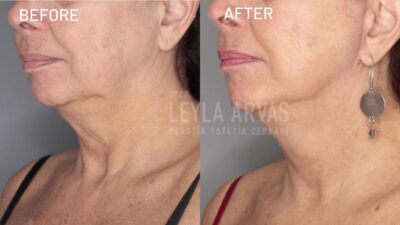 What is the High SMAS Face Lift Technique?
What is the High SMAS Face Lift Technique?
The High SMAS facelift technique is a type of facial rejuvenation surgery that focuses on lifting and tightening the SMAS layer in a more extensive manner. This technique is designed to address more significant signs of aging and provide a more dramatic improvement in facial contours. The steps of the procedure are similar to traditional SMAS face lift, but the incisions are usually made in a more extensive manner, and the SMAS layer is lifted higher on the face.
The procedure may also involve repositioning and tightening of the deep facial tissues, as well as the removal of excess skin. It’s important to note that the specific steps of the High SMAS facelift technique may vary depending on the individual’s needs and the surgeon’s preferred method. As with any surgical procedure, it’s important to discuss the risks, benefits, and expected results with a qualified plastic surgeon.
Is SMAS Face Lift a Permanent Operation?
SMAS face lift results are not permanent and will eventually be affected by the aging process. However, the effects of a smas lifting can be long-lasting, usually several years, depending on several factors such as the individual’s skin quality, the extent of the procedure, and lifestyle factors such as sun exposure and smoking.
While the results of a SMAS face lift are not permanent, they can be longer lasting than other types of facial rejuvenation procedures that only address the skin’s surface. Additionally, a well-performed SMAS face lift can help to delay the signs of aging by providing a more youthful and refreshed appearance.
It’s important to note that maintaining a healthy lifestyle, protecting skin from sun damage, and avoiding smoking can help to prolong the results of a SMAS face lift. In some cases, a touch-up procedure may be necessary to address the effects of aging that have occurred over time.
Risks of a SMAS Face Lift
Like any surgical procedure, there are risks associated with a SMAS face lift. Some of the risks include:
- Infection: There is a risk of infection after any surgical procedure, including a SMAS face lift. This risk can be minimized by following all post-operative care instructions and attending all follow-up appointments.
- Hematoma: A hematoma is a collection of blood that can occur after a surgical procedure. If a hematoma occurs after a SMAS face lift, it can result in swelling and pain.
- Nerve damage: There is a risk of nerve damage during the SMAS face lift procedure, which can result in numbness or a loss of sensation in the face.
- Unsatisfactory results: Like any surgical procedure, there is a risk of unsatisfactory results with a SMAS face lift. This risk can be minimized by choosing an experienced, qualified plastic surgeon.
Factors that Increase the Risks of smas lifting
There are several factors that can increase the risks associated with SMAS facelift. These include:
- Age:Older patients are at a higher risk of developing complications after SMAS facelift due to their weakened immune systems and slower healing processes.
- Smoking:Smoking can increase the risk of complications after SMAS facelift by reducing the oxygen supply to the skin and slowing the healing process.
- Medical Conditions:Patients with underlying medical conditions, such as diabetes or heart disease, are at a higher risk of developing complications after SMAS facelift.
Noninvasive Alternatives of SMAS Face Lift
There are several non-invasive alternatives to a SMAS (Superficial Musculo-Aponeurotic System) facelift, including:
- Botox injections: Botox injections can help smooth out wrinkles and fine lines by temporarily relaxing the muscles that cause them.
- Dermal fillers: Dermal fillers are used to fill in deep wrinkles, fine lines, and hollow areas in the face, providing a temporary youthful appearance.
- Chemical peels: Chemical peels use a solution to remove the outer layer of dead skin cells, revealing smoother, more radiant skin.
- Microdermabrasion: Microdermabrasion is a minimally invasive procedure that uses a special device to remove the top layer of dead skin cells, revealing smoother, clearer skin.
- Laser skin resurfacing: Laser skin resurfacing uses a high-energy light to remove the top layer of skin, promoting the growth of new, smoother skin.
- Radiofrequency treatments: Radiofrequency treatments use heat energy to tighten the skin and stimulate collagen production, helping to reduce the appearance of fine lines and wrinkles.
It’s important to note that while these non-invasive alternatives can provide a temporary improvement in the appearance of the skin, they may not provide the same results as a surgical facelift.
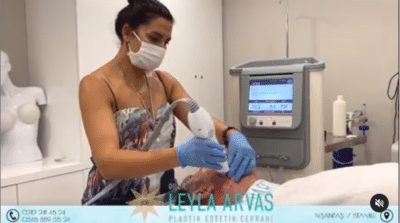 Minimally Invasive Alternatives for SMAS Face Lift
Minimally Invasive Alternatives for SMAS Face Lift
Minimally invasive alternatives to a SMAS (Superficial Musculo-Aponeurotic System) facelift include:
- Thread Lift: A thread lift involves the placement of absorbable sutures beneath the skin to lift sagging tissue and provide a more youthful appearance.
- Mini facelift: A mini facelift is a less invasive alternative to a full facelift that focuses on the lower third of the face, including the jowls and neck.
- Endoscopic facelift: An endoscopic facelift involves the use of a small camera and instruments to lift and tighten the underlying tissues of the face through small incisions.
- Liquid facelift: A liquid facelift involves the use of dermal fillers, Botox injections, and other non-invasive treatments to restore volume and smooth out wrinkles.
- Ultherapy: Ultherapy is a non-surgical facelift alternative that uses ultrasound energy to tighten the skin and stimulate collagen production.
It’s important to consult with a board-certified plastic surgeon to determine which minimally invasive alternative is best suited for your individual needs and goals. Your surgeon can also provide you with a detailed understanding of the risks, benefits, and expected outcomes of each option.
Frequently Asked Questions
Is SMAS Face Lift right for me? SMAS Face Lift may be a good option for individuals who are looking to improve the appearance of the face and combat the signs of aging. However, it is important to discuss your goals and expectations with a qualified cosmetic surgeon to determine if the procedure is right for you.
Is SMAS Face Lift painful? The procedure is performed under anesthesia, so patients should not feel any pain during the procedure. However, some discomfort and swelling may occur after the procedure, but this can be managed with over-the-counter pain medication.
How long do the results of SMAS Face Lift last? The results of SMAS Face Lift can last for several years, although this can vary depending on factors such as age and skin type. The procedure provides a more long-lasting improvement compared to other non-invasive cosmetic procedures, and the results can be maintained with regular skin care and sun protection.
Will there be scars after the procedure? The incisions made during the procedure are designed to be discreet and are typically located in areas that are easily concealed, such as in front of the ear or within the hairline. The incisions are closed with sutures or surgical tape, and the scars should fade over time.
Can SMAS Face Lift be combined with other procedures? Yes, SMAS Face Lift can be combined with other cosmetic procedures, such as eyelid surgery or facial injectables, to achieve a more comprehensive rejuvenation. This should be discussed with your cosmetic surgeon to determine the best approach for your individual needs and goals.
The Recovery Process of smas lifting
The recovery process for a SMAS face lift is typically shorter than a traditional face lift, but it is still important to allow your body the time it needs to heal. Some of the things you can expect during the recovery process include:
- Swelling: Swelling is normal after a SMAS face lift and can last for several days.
- Bruising: Bruising is also normal after a SMAS face lift and can last for several days to several weeks.
- Pain: Pain is typically minimal after a SMAS face lift, but your plastic surgeon may prescribe pain medication to help manage any discomfort.
- Rest: It is important to rest
How Much does smas lifting price in Istanbul, Turkey?
The price of SMAS Face Lift operation may vary depending on several factors. These factors can be listed as the experience of the doctor, the content of the surgery to be performed, and the city where the clinic is located in İstanbul.
In addition to this,smas lifting price; It also affects the doctor’s price, the hospital price where the surgery will be performed, the anesthesia price, the additional tests performed, and the prescribed drugs. When this situation is taken into consideration, it is appropriate for you to learn the most accurate information after the examination, after a detailed evaluation of the scope of your SMAS face lift operation and the additional procedures deemed necessary. You can learn your price information in the most accurate way at the end of the examination.
smas lift cost (Superficial Musculo-Aponeurotic System) facelift in Istanbul, Turkey on average, a smas lift cost in Istanbul can cost anywhere from $4,000 to $8,000, although prices can be higher or lower depending on the specific circumstances.
It’s important to keep in mind that smas lift cost is only one factor to consider when making the decision to undergo a cosmetic procedure. You should also consider the qualifications and experience of the surgeon, the safety and cleanliness of the surgical facility, and the potential risks and benefits of the procedure.
If you’re considering a SMAS facelift in Istanbul, it’s a good idea to consult with several qualified plastic surgeons to compare prices, services, and results. This will help you make an informed decision and ensure that you receive the best possible care.
For Ministry of Health-accredited centers, it is not legal to specify prices on their website. Therefore, please dial 0212 241 46 24 to contact Quartz Clinique and get information on smas lifting price In İSTANBUL, TURKEY.


